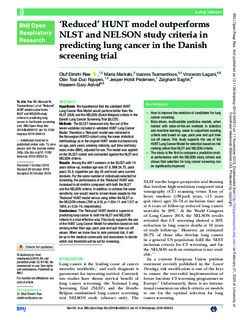| dc.contributor.author | Røe, Oluf Dimitri | |
| dc.contributor.author | Markaki, Maria | |
| dc.contributor.author | Tsamardinos, Ioannis | |
| dc.contributor.author | Lagani, Vincenzo | |
| dc.contributor.author | Nguyen, Olav Toai Duc | |
| dc.contributor.author | Pedersen, Jesper Holst | |
| dc.contributor.author | Saghir, Zaigham | |
| dc.contributor.author | Ashraf, Haseem | |
| dc.date.accessioned | 2020-02-24T07:30:17Z | |
| dc.date.available | 2020-02-24T07:30:17Z | |
| dc.date.created | 2019-12-05T11:16:27Z | |
| dc.date.issued | 2019 | |
| dc.identifier.citation | BMJ Open Respiratory Research. 2019, 6 (1), 1-9. | nb_NO |
| dc.identifier.issn | 2052-4439 | |
| dc.identifier.uri | http://hdl.handle.net/11250/2643312 | |
| dc.description.abstract | Hypothesis We hypothesise that the validated HUNT Lung Cancer Risk Model would perform better than the NLST (USA) and the NELSON (Dutch‐Belgian) criteria in the Danish Lung Cancer Screening Trial (DLCST).
Methods The DLCST measured only five out of the seven variables included in validated HUNT Lung Cancer Model. Therefore a ‘Reduced’ model was retrained in the Norwegian HUNT2-cohort using the same statistical methodology as in the original HUNT model but based only on age, pack years, smoking intensity, quit time and body mass index (BMI), adjusted for sex. The model was applied on the DLCST-cohort and contrasted against the NLST and NELSON criteria.
Results Among the 4051 smokers in the DLCST with 10 years follow-up, median age was 57.6, BMI 24.75, pack years 33.8, cigarettes per day 20 and most were current smokers. For the same number of individuals selected for screening, the performance of the ‘Reduced’ HUNT was increased in all metrics compared with both the NLST and the NELSON criteria. In addition, to achieve the same sensitivity, one would need to screen fewer people by the ‘Reduced’ HUNT model versus using either the NLST or the NELSON criteria (709 vs 918, p=1.02e-11 and 1317 vs 1668, p=2.2e-16, respectively).
Conclusions The ‘Reduced’ HUNT model is superior in predicting lung cancer to both the NLST and NELSON criteria in a cost-effective way. This study supports the use of the HUNT Lung Cancer Model for selection based on risk ranking rather than age, pack year and quit time cut-off values. When we know how to rank personal risk, it will be up to the medical community and lawmakers to decide which risk threshold will be set for screening. | nb_NO |
| dc.language.iso | eng | nb_NO |
| dc.publisher | BMJ Publishing Group | nb_NO |
| dc.rights | Navngivelse-Ikkekommersiell 4.0 Internasjonal | * |
| dc.rights.uri | http://creativecommons.org/licenses/by-nc/4.0/deed.no | * |
| dc.title | ‘Reduced’ HUNT model outperforms NLST and NELSON study criteria in predicting lung cancer in the Danish screening trial | nb_NO |
| dc.type | Journal article | nb_NO |
| dc.type | Peer reviewed | nb_NO |
| dc.description.version | publishedVersion | nb_NO |
| dc.source.pagenumber | 1-9 | nb_NO |
| dc.source.volume | 6 | nb_NO |
| dc.source.journal | BMJ Open Respiratory Research | nb_NO |
| dc.source.issue | 1 | nb_NO |
| dc.identifier.doi | 10.1136/bmjresp-2019-000512 | |
| dc.identifier.cristin | 1757041 | |
| dc.description.localcode | his is an open access article distributed in accordance with the Creative Commons Attribution Non Commercial (CC BY-NC 4.0) license, which permits others to distribute, remix, adapt, build upon this work non-commercially, and license their derivative works on different terms, provided the original work is properly cited, appropriate credit is given, any changes made indicated, and the use is non-commercial. See: http://creativecommons.org/licenses/by-nc/4.0/. | nb_NO |
| cristin.unitcode | 194,65,15,0 | |
| cristin.unitname | Institutt for klinisk og molekylær medisin | |
| cristin.ispublished | true | |
| cristin.fulltext | original | |
| cristin.qualitycode | 1 | |

